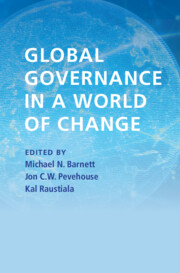 |
| (Image Source: CUP) |
Book description:
Global governance has come under increasing pressure since the end of the Cold War. In some issue areas, these pressures have led to significant changes in the architecture of governance institutions. In others, institutions have resisted pressures for change. This volume explores what accounts for this divergence in architecture by identifying three modes of governance: hierarchies, networks, and markets. The authors apply these ideal types to different issue areas in order to assess how global governance has changed and why. In most issue areas, hierarchical modes of governance, established after World War II, have given way to alternative forms of organization focused on market or network-based architectures. Each chapter explores whether these changes are likely to lead to more or less effective global governance across a wide range of issue areas. This provides a novel and coherent theoretical framework for analysing change in global governance.
Table of Contents:
Introduction: the modes of global governance Michael Barnett, Jon Pevehouse and Kal Raustiala
1. Governance shifts in security: military and security services and small arms compared Deborah Avant
2. The Bretton woods moment: hierarchies, networks, and markets in the long twentieth century Miles Kahler
3. Climate change governance: past, present and (hopefully) future Jessica Green
4. A shadow of its former self: hierarchy and global trade Susanne Mueller and Jon Pevehouse
5. The humanitarian club: hierarchy, networks, and exclusion Michael Barnett
6. The supply of informal international governance: hierarchy plus networks in global governance Michael Manulak and Duncan Snidal
7. Global governance, expert networks, and 'Fragile States' Leonard Seabrooke and Ole Jacob Sending
8. Global health: a centralized network in search of hierarchy Surie Moon
9. The governance of International Humanitarian Law: a century-old hybrid model Anne Quintin and Vincent Bernard
10. Clean energy and the hybridization of global governance Lilliana Andonova
11. Legitimacy and modes of global governance Jonas Tallberg
Conclusion: global governance and institutional diversity Orfeo Fioretos.

